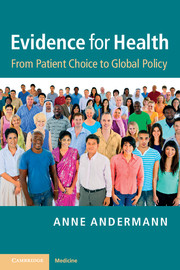Book contents
- Frontmatter
- Contents
- Foreword
- Preface
- Endorsements
- About the author
- Acknowledgments
- 1 Introduction
- 2 Strategies for improving health
- 3 Understanding how decisions influence health
- 4 Producing evidence to inform health decisions
- 5 Facilitators and barriers to using evidence
- 6 Making evidence-informed decisions
- 7 Conclusion
- Index
- References
4 - Producing evidence to inform health decisions
Published online by Cambridge University Press: 05 February 2013
- Frontmatter
- Contents
- Foreword
- Preface
- Endorsements
- About the author
- Acknowledgments
- 1 Introduction
- 2 Strategies for improving health
- 3 Understanding how decisions influence health
- 4 Producing evidence to inform health decisions
- 5 Facilitators and barriers to using evidence
- 6 Making evidence-informed decisions
- 7 Conclusion
- Index
- References
Summary
Since the purpose of this book is to help people make better-informed decisions about improving health and reducing health inequities, an important question is what counts as evidence in supporting these decisions? Often, if a person has a health problem, they might ask a family member or a friend for advice. If they are sufficiently concerned that this health problem could be serious, they may make an appointment to go see their family doctor or a local lay health worker and ask them what to do. In this technological age, many people learn about health issues from the media or go on the Internet and use Google to find guidance. In government, high-level officials – who may not have any health training even though they are responsible for important decisions that affect the health of thousands or even millions of people – often turn to their scientific and technical advisors for assistance. Friends, family, newspapers, television, blogs and so on, are all sources of health information. But, will this information lead to better-informed decisions? Doctors and technical advisors may have greater knowledge about what makes individuals and populations healthy, but what evidence do they use as a basis when they provide advice? When a friend recommends chicken soup for a cold because that is what he learned from his grandmother, does this count as evidence? What if the friend says that the chicken soup helped someone else to feel better when they had a cold – now is this evidence? What if the friend says that they read in the newspaper that a randomised controlled trial of chicken soup versus placebo reduced the average length of a cold from seven to five days – now is this evidence? What about when it comes to social policies – what would be the optimal length of parental leave to promote health? Is 3 months enough? What about 12 months? How could one investigate this? The purpose of this chapter is to explore further what counts as evidence, how evidence is produced and how it can be used to make better-informed decisions to improve health.
- Type
- Chapter
- Information
- Evidence for HealthFrom Patient Choice to Global Policy, pp. 74 - 120Publisher: Cambridge University PressPrint publication year: 2012



